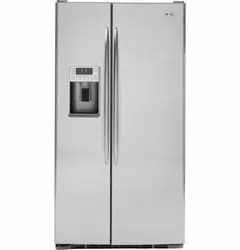Documents: Go to download!
User Manual
- Owner's manual - (English, French, Spanish)
- Quick specs - (English)
- About the temperature controls
- About Set Features.
- About TurboCool.™
- About ClimateKeeper2.™ (on some models)
- About CustomCool ™ . (on some models)
- About ExpressChill ™ . (on some models)
- About the shelves and bins.
- About the crispers and pans.
- About crisper removal.
- About the automatic ice maker
- Replacing the light bulbs. (on some models)
- Installation Instructions
- Before you call for service…
Table of contents
User manual Refrigerator
About the temperature controls
Not all features are on all models. Your controls may be similar to the following:
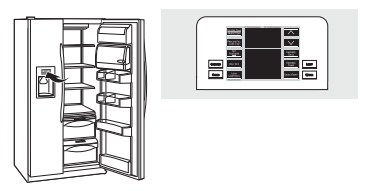
Touch-LED Dispenser Control
NOTE: The refrigerator is shipped with protective film covering the temperature controls. If this film was not removed during installation, remove it now.
The temperature controls are preset in the factory at 37°F (3°C) for the refrigerator compartment and 0°F (-18°C) for the freezer compartment. Allow 24 hours for the temperature to stabilize to the preset recommended settings.
Refrigerator temperatures can be adjusted between 34°F and 46°F (1°C to 8°C), and the freezer temperatures can be adjusted between –6°F and +8°F (–21°C to –13°C).
To change the Refrigerator temperature: Tactile-LED Dispenser Control
The temperature controls can display both the SET temperature as well as the actual temperature in the refrigerator and freezer. The actual temperature may vary slightly from the SET temperature based on usage and operating environment.
- On some models, setting both controls to the warmest setting until the display flashes (off) will stop cooling in both the freezer and refrigerator compartments.
- On other models, setting either control to the warmest setting until the display flashes (off) will stop the cooling to the freezer and refrigerator.
- NOTE: Turning the refrigerator off via the controls on the touch panel does not shut off electrical power to the refrigerator.
NOTE: The refrigerator is shipped with protective film covering the temperature controls. If this film was not removed during installation, remove it now
Touch-LED Dispenser Control:
To change the temperature, press and release the FREEZER TEMP/FRIDGE TEMP pad. The SET light will come on and the display will show the set temperature. To change the temperature, tap either the ^ or v pad until the desired temperature is displayed.

Tactile LED Dispenser Control.
Once the desired temperature has been set, the temperature display will return to the actual refrigerator and freezer temperatures after 5 seconds. Several adjustments may be required. Each time you adjust the controls, allow 24 hours for the refrigerator to reach the temperature you have set.
The temperature controls can display both the SET temperature as well as the actual temperature in the refrigerator and freezer. The actual temperature may vary slightly from the SET temperature based on usage and operating environment.
Turning the cooling system off: Tactile-LED Dispenser Control
- On some models, setting both controls to the warmest setting until the display flashes (off) will stop cooling in both the freezer and refrigerator compartments.
- On other models, setting either control to the warmest setting until the display flashes (off) will stop the cooling to the freezer and refrigerator.
- NOTE: Turning the refrigerator off via the controls on the touch panel does not shut off electrical power to the refrigerator.
Touch-LED Dispenser Control:
Press and release the FREEZER TEMP/FRIDGE TEMP pad. Press ^ to set freezer temperature to 5. The display will show OFF. To turn the unit back on, press the FREEZER TEMP/FRIDGE TEMP pad. Press ^ to set the freezer and refrigerator temperatures to the preset points of 0°F (-18°C) for the freezer and 37°F (3°C) for the refrigerator.
When the unit is turned back on, it will take up to 24 hours to stabilize.
About Set Features.
This pad is used to select the following features: TurboCool, Quick Ice, Door Alarm and Water Filter.
Pressing SET FEATURES repeatedly will cycle through all of the available features and then exit the mode. If no key is pressed, the mode will exit and return to displaying features currently set.
About TurboCool.™

How it Works
TurboCool™ rapidly cools the refrigerator compartment in order to more quickly cool foods. Use TurboCool™ when adding a large amount of food to the refrigerator compartment, putting away foods after they have been sitting out at room temperature or when putting away warm leftovers. It can also be used if the refrigerator has been without power for an extended period.
Once activated, the compressor will turn on immediately and the fans will cycle on and off at high speed as needed for eight hours. The compressor will continue to run until the refrigerator compartment cools to approximately 34°F (1°C), then it will cycle on and off to maintain this setting. After 8 hours, or if TurboCool™ is pressed again, the refrigerator compartment will return to the original setting.
How to Use
Tactile LED Dispenser Control: Press TurboCool™. The TurboCool temperature display will show Tc and the LED will be activated. After TurboCool™ is complete, the TurboCool™ indicator light will go out.
NOTES:
- The refrigerator temperature cannot be changed during TurboCool™.
- The freezer temperature is not affected during TurboCool™.
- When opening the refrigerator door during TurboCool™, the fans will continue to run if they have cycled on.
Touch-LED Dispenser Controls:
Press SET FEATURES. The refrigerator temperature display will show TurboCool™ and/or TC. Press ON/OFF.
After TurboCool™ is complete, the refrigerator compartment will return to the original setting.
NOTES:
- The refrigerator temperature cannot be changed during TurboCool™.
- The freezer temperature is not affected during TurboCool™.
- When opening the refrigerator door during TurboCool™, the fans will continue to run if they have cycled on.
About ClimateKeeper2.™ (on some models)

How it Works
The ClimateKeeper2™ is the industry’s most advanced refrigeration system, delivering optimum temperature and humidity performance to keep food garden fresh longer and reduce freezer burn.
The ClimateKeeper2™ system features two HYDSRUDWRUV³RQHIRUWKHUHIULJHUDWRUDQGRQH for the freezer.
This provides two separate cooling systems, and separates the airflow between the fresh food and freezer compartments during normal cooling operations.*
This ensures that the humidity levels in the fresh food compartment are significantly higher than in a conventional system,** allowing fresh produce and other unsealed foods to retain their moisture content and freshness longer. Moisture sensitive foods such as fresh fruit, salads, rice, etc., can now be stored on open shelves without excessive moisture loss.
Due to the higher humidity in the refrigerator, you may on occasion experience fog or small amounts of moisture in the refrigerator compartment. This is normal and may come and go as different food loads and environmental conditions change. Wipe dry with a paper towel if desired.
The separate airflow system minimizes the mixing of air between the two compartments, which reduces fresh food odor transfer to improve the taste of ice.
The ClimateKeeper2™ system also reduces the number of defrosting cycles in the freezer evaporator, thereby reducing freezer burn.
* Freezer air is used in the CustomCool feature.
** Testing shows a higher level of humidity in the Fresh Food section in ClimateKeeper2™ refrigerators versus conventional units.
About CustomCool ™ . (on some models)
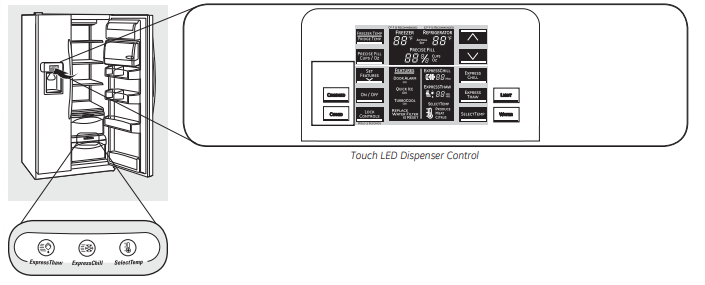
How it Works
The CustomCool™ feature is used to quickly chill items, thaw items or hold the pan at a specific temperature. This feature is a system of dampers, a fan, a temperature thermistor and a heater.
The pan is tightly sealed to prevent temperature fluctuations in the rest of the refrigerator.
The controls for this pan are located on the dispenser with the temperature controls.
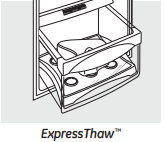
How to Use
1. Empty the pan. Place the Chill/Thaw tray in the pan. Place the items on the tray and close the pan completely.
2. Touch LED Dispenser Control: Select the ExpressThaw™, ExpressChill™ or SelectTemp™ pad. The display and SET light will come on. Tap the pad until the light appears next to the desired setting. Use the following chart to determine the best setting to use.
- ExpressChill can be set to 15, 30 or 45 minutes. The default is 15 minutes.
- To stop a feature before it is finished: tap that feature’s pad until no options are selected and the display is off.
- During ExpressThaw and ExpressChill, the display on the controls will count down the time in the cycle (on some models).
- After the ExpressThaw cycle is complete, the pan will reset to the MEAT setting (32°F [0°C]) to help preserve thawed items until they are used.
- The displayed actual temperature of the CustomCool pan may vary slightly from the SET temperature based on usage and operating environment.
NOTE: For food safety reasons, it is recommended that foods be wrapped in plastic wrap when using ExpressThaw. This will help contain meat juices and improve thawing performance.
About ExpressChill ™ . (on some models)

How it Works
The ExpressChill™ feature is a system of dampers, a fan and a temperature thermistor.
The pan is tightly sealed to prevent the pan’s temperature from causing temperature fluctuations in the rest of the refrigerator.
The controls for this pan are located in the top of the refrigerator or on the dispenser with the temperature controls.

How to Use
1. Empty the pan. Place the Chill tray in the pan. Place the items on the tray and close the pan completely.
2. Select the ExpressChill™ pad. On some models, you can then select the chill time (use chart to determine best setting). Other models will only have one option (45 minutes). On models with multiple settings, tap the pad until the light appears next to the desired setting.
- To stop a feature before it is finished, tap that feature’s pad until no options are selected and the display is off.
- During ExpressChill, the display on the controls will count down the time in the cycle.

How to Remove and Replace the Drawer
To remove:
- Pull the drawer out to the stop position.
- Rotate all four swing locks to the unlock position.
- Lift the front of the drawer up and out.
To replace:
- Make sure all four swing locks are in the unlock position.
- Place the sides of the drawer into the drawer supports, making sure the swing locks fit on the drawer slots.
- Lock all four swing locks by rotating them to the lock position.
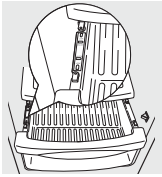
About the shelves and bins.
Not all features are on all models.

Refrigerator Door Bins and Freezer Door Tilt-Out Bins
Bins
The larger refrigerator door bins and freezer tilt-out door bins are adjustable.
To remove: Lift the front of the bin straight up, then lift up and out.
To replace or relocate: Engage the back side of the bin in the molded supports on the door. Then push down on the front of the bin. Bin will lock in place.
The snugger helps prevent tipping, spilling or sliding of small items stored on the door shelf. Place a finger on either side of the snugger near the rear and move it back and forth to fit your needs.
Top Freezer Bins
CAUTION: Be careful when placing items in the top bin. Make sure that items do not block or fall into the ice chute.
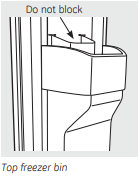
CAUTION: Part must be in place as shown for proper ice dispensing. Food cannot be stored in this location.

Slide-Out Spillproof Shelf
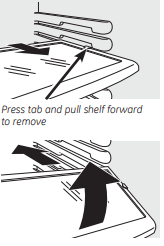
The slide-out spillproof shelf allows you to reach items stored behind others. The special edges are designed to help prevent spills from dripping to lower shelves.
To remove:
Slide the shelf out until it reaches the stop, then press down on the tab and slide the shelf straight out.
To replace or relocate:
Line the shelf up with the supports and slide it into place. The shelf can be repositioned when the door is at 90° or more. To reposition the shelf, slide the shelf past the stops and angle downward. Slide shelf down to the desired position, line up with the supports and slide into place.
Make sure you push the shelves all the way back in before you close the door.
QuickSpace™ Shelf
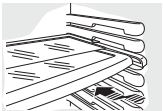
This shelf splits in half and slides under itself for storage of tall items on the shelf below.
This shelf can be removed and replaced or relocated just like Slide-Out Spillproof Shelves.
On some models, this shelf cannot be used in the lowest position.
About the crispers and pans.
About the crispers and pans.
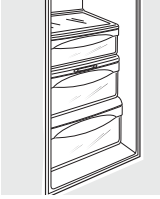
Fruit and Vegetable Crispers
Excess water that may accumulate in the bottom of the drawers should be wiped dry.
On some models, the bottom drawer has full extension slides that allow full access to the drawer.

Adjustable Humidity Crispers
Slide the control all the way to the HI setting to provide high humidity recommended for most vegetables.
Slide the control all the way to the LO setting to provide lower humidity levels recommended for most fruits.

Convertible Deli Pan
The convertible deli pan has its own cold air duct to allow a stream of cold air from the freezer compartment or fresh food compartment to flow to the pan.
The variable temperature control regulates the air flow from the Climate Keeper Air Tower.
Set the control to the coldest setting to store fresh meats.
Set the control to cold to convert the pan to normal refrigerator temperature and provide extra vegetable storage space.
The cold air duct is turned off. Variable settings between these extremes can be selected.
About crisper removal.
Not all features are on all models.
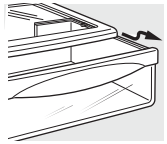
Crisper Removal
Crispers can easily be removed by pulling the drawer straight out and lifting the drawer up and over the stop location.
If the door prevents you from taking out the drawers, first try to remove the door bins. If this does not offer enough clearance, the refrigerator will need to be rolled forward until the door opens enough to slide the drawers out. In some cases, when you roll the refrigerator out, you will need to move the refrigerator to the left or right as you roll it out.
About the automatic ice maker
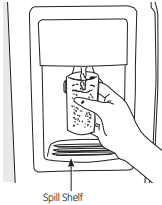
To Use the Dispenser
Select CUBED, CRUSHED or WATER.
Press the glass gently against the top of the dispenser cradle.
The spill shelf is not self-draining. To reduce water spotting, the shelf and its grille should be cleaned regularly.
If no water is dispensed when the refrigerator is first installed, there may be air in the water line system. Press the dispenser arm for at least two minutes to remove trapped air from the water line and to fill the water system. To flush out impurities in the water line, throw away the first six glassfuls of water.
CAUTION: Never put fingers or any other objects into the ice crusher discharge opening
Locking the Dispenser
Press the LOCK or LOCK CONTROLS pad for 3 seconds to lock the dispenser and control panel. To unlock, press and hold the pad again for 3 seconds.
Dispenser Light
The LIGHT pad turns the night light in the dispenser on and off. The light also comes on when the dispenser cradle is pressed. For models with a bulb, if the light burns out, it should be replaced with a 6 watt 12V maximum bulb. For LED models contact Factory Service.
Door Alarm
Use Door Alarm to sound if either door is open for more than 3 minutes. The alarm will stop once the door is closed. For LCD models, a popup screen will appear. The alarm can be silenced by touching the LCD screen.
Touch LED Dispenser Control:
Press the SET FEATURES pad once and DOOR ALARM will blink. Press ON/OFF and the door alarm will be set and the icon will turn solid. Press ON/OFF again to turn the alarm off.
Door Alarm (on Tactile LED Dispenser Control model)

To set the alarm, press this pad until the indicator light comes on. This alarm will sound if either door is open for more than 3 minutes. The light goes out and the beeping stops when you close the door.
Quick Ice
When you need to speed up ice production, use the Quick Ice feature. While this feature is turned on, the freezer fan runs continuously for 48 hours, or until the feature is turned OFF. During this period, ice production will increase up to 40%. Models with the integrated ice feature system require at FIRST USE at least half an 8 oz. glass of ice to be dispensed every 6 to 12 hours. This will help the ice maker fill the bucket properly so that dispensing is better.
How to Use
Touch LED Dispenser Control:
Press the SET FEATURES pad twice and QUICK ICE will blink. Press ON/OFF to turn the feature on, then again to turn it off.
Quick Ice (on Tactile LED Dispenser Control model)

When you need ice in a hurry, press this pad to speed up ice production. This will increase ice production for the following 48 hours or until you press the pad again.
Care and cleaning of the refrigerator.

Cleaning the Outside
The dispenser drip area, beneath the grille, should be wiped dry. Water left in this area may leave deposits. Remove the deposits by adding undiluted vinegar to the well. Soak until the deposits disappear or become loose enough to rinse away.
The dispenser cradle. Before cleaning, lock the dispenser by pressing and holding the LOCK or LOCK CONTROLS pad for 3 seconds. Clean with warm water and baking soda solution - about a tablespoon (15 ml) of baking soda to a quart (1 liter) of water. Rinse thoroughly and wipe dry
The door handles and trim. Clean with a cloth dampened with soapy water. Dry with a soft cloth.
The stainless steel panels and door handles (on some models) can be cleaned with a commercially available stainless steel cleaner. A spray-on stainless steel cleaner works best.
Do not use appliance wax or polish on the stainless steel.
Keep the outside clean. Wipe with a clean cloth lightly dampened with kitchen appliance wax or mild liquid dish detergent. Dry and polish with a clean, soft cloth.
Do not wipe the refrigerator with a soiled dish cloth or wet towel. These may leave a residue that can erode the paint. Do not use scouring pads, powdered cleaners, bleach or cleaners containing bleach because these products can scratch and weaken the paint finish.
Cleaning the Inside
To help prevent odors, leave an open box of baking soda in the fresh food and freezer compartments.
Unplug the refrigerator before cleaning.
If this is not practical, wring excess moisture out of sponge or cloth when cleaning around switches, lights or controls.
Use warm water and baking soda solution about a tablespoon (15 ml) of baking soda to a quart (1 liter) of water. This both cleans and neutralizes odors. Rinse and wipe dry.
Use of any cleaning solution other than that which is recommended, especially those that contain petroleum distillates, can crack or damage the interior of the refrigerator.
Avoid cleaning cold glass shelves with hot water because the extreme temperature difference may cause them to break.
Handle glass shelves carefully. Bumping tempered glass can cause it to shatter.
Do not wash any plastic refrigerator parts in the dishwasher.
The chill/thaw tray is dishwasher safe.
Behind the Refrigerator
Be careful when moving the refrigerator away from the wall. All types of floor coverings can be damaged, particularly cushioned coverings and those with embossed surfaces.
Pull the refrigerator straight out and return it to position by pushing it straight in. Moving the refrigerator in a side direction may result in damage to the floor covering or refrigerator.
When pushing the refrigerator back, make sure you don’t roll over the power cord or ice maker supply line.
Preparing for Vacation
For long vacations or absences, remove food and unplug the refrigerator. Clean the interior with a baking soda solution of one tablespoon (15 ml) of baking soda to one quart (1 liter) of water. Leave the doors open.
Set the ice maker power switch to the O (off) position and shut off the water supply to the refrigerator.
If the temperature can drop below freezing, have a qualified servicer drain the water supply system to prevent serious property damage due to flooding.
Preparing to Move
Secure all loose items such as shelves and drawers by taping them securely in place to prevent damage.
When using a hand truck to move the refrigerator, do not rest the front or back of the refrigerator against the hand truck. This could damage the refrigerator. Handle only from the sides of the refrigerator.
Be sure the refrigerator stays in an upright position during moving
Replacing the light bulbs. (on some models)
NOTE: Turning the refrigerator off via the controls on the touch panel does not shut off electrical power to the refrigerator or to the light circuit.

Refrigerator Comparment - Upper Light
- Unplug the refrigerator.
- The bulbs are located at the top of the compartment, inside the light shield. On some models, a screw at the front of the light shield will have to be removed. On other models, the screw is located in the pocket located at the back of the light shield.
- To remove the light shield, on some models, press in on the tabs on the sides of the shield and slide forward and out. On other models, just slide the shield forward and out.
- After replacing the bulb with an appliance bulb of the same or lower wattage, replace the light shield and screws (on some models). When replacing the light shield, make sure that the tabs at the back of the shield fit into the slots at the back of the light shield housing.
- Plug the refrigerator back in.
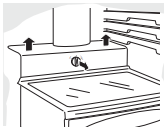
Refrigerator Comparment - Lower Light
This light is located above the top drawer.
- Unplug the refrigerator.
- Remove the convertible meat drawer control knob by pulling straight out.
- Lift the light shield up and pull it out.
- After replacing the bulb with an appliance bulb of the same or lower wattage, replace the shield and the knob.
- Plug the refrigerator back in.
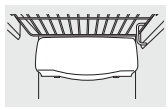
Dispenser (on some models)
- Unplug the refrigerator.
- The bulb is located on the dispenser under the control panel. Remove the light bulb by turning it counterclockwise.
- Replace the bulb with a bulb of the same size and wattage.
- Plug the refrigerator back in.
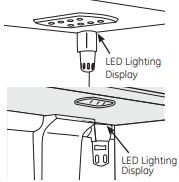
Refrigerator Compartment (on models with LED lighting)
Some models may have LED lighting display on the top and/or sides of the fresh food compartment and in the rear and side of the freezer compartment
If this assembly needs to be replaced, call GE Service at 1.800.432.2737 in the United States or 1.800.561.3344 in Canada.
Installation Instructions
1 CONNECTING THE REFRIGERATOR TO THE HOUSE WATER LINE (ice maker and dispenser models)
A cold water supply is required for automatic ice maker and dispenser operation. If there is not a cold water supply, you will need to provide one. See Installing the Water Line section.
NOTES:
- Before making the connection to the refrigerator, be sure the refrigerator power cord is not plugged into the wall outlet.
- If your refrigerator does not have a water filter, we recommend installing one if your water supply has sand or particles that could clog the screen of the refrigerator’s water valve. Install it in the water line near the refrigerator. If using GE SmartConnect™ Refrigerator Tubing Kit, you will need an additional tube (WX08X10002) to connect the filter. Do not cut plastic tube to install filter.
A. If you are using copper tubing, place a compression nut and ferrule (sleeve) onto the end of the tubing coming from the house cold water supply.
If you are using the GE SmartConnect™ tubing, the nuts are already assembled to the tubing.
B. If you are using copper tubing, insert the end of the tubing into the refrigerator connection, at the back of the refrigerator, as far as possible. While holding the tubing, tighten the fitting.
If you are using GE SmartConnect™ tubing, insert the molded end of the tubing into the refrigerator connection, at the back of the refrigerator, and tighten the compression nut until it is hand tight. Then tighten one additional turn with a wrench. Overtightening may cause leaks.
C. Fasten the tubing into the clamp provided to hold it in position. You may need to pry open the clamp.
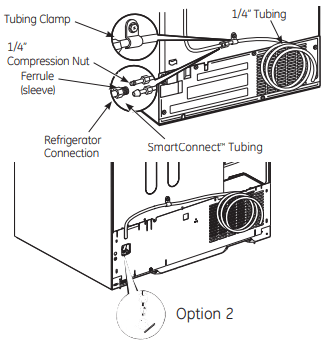
2. TURN ON THE WATER SUPPLY
Turn the water on at the shutoff valve (house water supply) and check for any leaks.
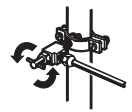
3. PLUG IN THE REFRIGERATOR
Before plugging in the refrigerator, make sure the ice maker power switch is set to the O (off) position.
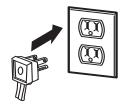
See the grounding information attached to the power cord.
4. PUT THE REFRIGERATOR IN PLACE
Move the refrigerator to its final location.
5. LEVEL THE REFRIGERATOR
The refrigerator can be leveled by adjusting the rollers located near the bottom hinges.
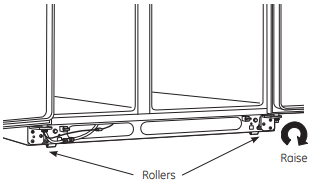
Rollers have three purposes:
- Rollers adjust so the door closes easily when opened about halfway. (Raise the front about 5/8” [16 mm] from the floor.)
- Rollers adjust so the refrigerator is firmly positioned on the floor and does not wobble.
- Rollers allow you to move the refrigerator away from the wall for cleaning.
To adjust the rollers on 23‘ (33” wide), 25‘, 26‘, 27‘ and 29‘ models:
- Turn the roller adjusting screws clockwise to raise the refrigerator, counterclockwise to lower it. Use a 3/8” hex socket or wrench, or an adjustable wrench.
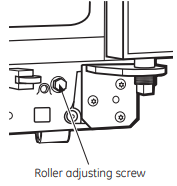
To adjust the rollers on 23‘/25‘ CustomStyle™ models:
Turn the front roller adjusting screws clockwise to raise the refrigerator, counterclockwise to lower it. Use a 3/8” hex wrench with extension, or an adjustable wrench.
These models also have rear adjustable rollers so you can align the refrigerator with your kitchen cabinets. Use a 3/8” hex wrench with extension to turn the screws for the rear rollers - clockwise to raise the refrigerator, counterclockwise to lower it.
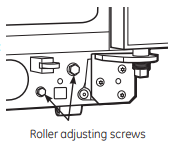
6. LEVEL THE DOORS
Adjust the refrigerator door to make the doors even at the top.
To align:
A. Using a 7/16” wrench, turn the door adjusting screw to the right to raise the door, to the left to lower it.
NOTE: A nylon plug, imbedded in the threads of the pin, prevents the pin from turning unless a wrench is used.
B. After one or two turns of the wrench, open and close the refrigerator door and check the alignment at the top of the doors.

7. REPLACE THE BASE GRILLE
Replace the grille by installing the two Phillips head screws.

8. SET THE CONTROLS
Set the controls to the recommended setting.
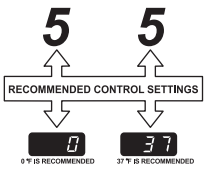
9. START THE Ice maker
Set the ice maker power switch to the I (on) position. The ice maker will not begin to operate until it reaches its operating temperature of 15°F (–9°C) or below. It will then begin operation automatically. It will take 2–3 days to fill the ice bin.

NOTE: In lower water pressure conditions, the water valve may turn on up to 3 times to deliver enough water to the ice maker.
Installation Instructions
Install the shutoff valve on the nearest frequently used drinking water line.
1. SHUT OFF THE MAIN WATER SUPPLY
Turn on the nearest faucet long enough to clear the line of water.
2. CHOOSE THE VALVE LOCATION
Choose a location for the valve that is easily accessible. It is best to connect into the side of a vertical water pipe. When it is necessary to connect into a horizontal water pipe, make the connection to the top or side, rather than at the bottom, to avoid drawing off any sediment from the water pipe.

3. DRILL THE HOLE FOR THE VALVE
Drill a 1/4” hole in the water pipe (even if using a self-piercing valve), using a sharp bit. Remove any burrs resulting from drilling the hole in the pipe.
Take care not to allow water to drain into the drill.
Failure to drill a 1/4” hole may result in reduced ice production or smaller cubes.

4. FASTEN THE SHUTOFF VALVE
Fasten the shutoff valve to the cold water pipe with the pipe clamp.
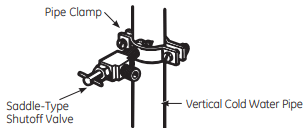
NOTE: Commonwealth of Massachusetts Plumbing Codes 248CMR shall be adhered to. Saddle valves are illegal and use is not permitted in Massachusetts. Consult with your licensed plumber.
5 TIGHTEN THE PIPE CLAMP
Tighten the clamp screws until the sealing washer begins to swell.
NOTE: Do not overtighten or you may crush the tubing.

6. ROUTE THE TUBING
Route the tubing between the cold water line and the refrigerator.
Route the tubing through a hole drilled in the wall or floor (behind the refrigerator or adjacent base cabinet) as close to the wall as possible.
NOTE: Be sure there is sufficient extra tubing to allow the refrigerator to move out from the wall after installation.
7. CONNECT THE TUBING TO THE VALVE
Place the compression nut and ferrule (sleeve) for copper tubing onto the end of the tubing and connect it to the shutoff valve.
Make sure the tubing is fully inserted into the valve. Tighten the compression nut securely.
For plastic tubing from a GE SmartConnect™ Refrigerator Tubing kit, insert the molded end of the tubing into the shutoff valve and tighten compression nut until it is hand tight, then tighten one additional turn with a wrench. Overtightening may cause leaks.

NOTE: Commonwealth of Massachusetts Plumbing Codes 248CMR shall be adhered to. Saddle valves are illegal and use is not permitted in Massachusetts. Consult with your licensed plumber.
8. FLUSH OUT THE TUBING
Turn the main water supply on and flush out the tubing until the water is clear.
Shut the water off at the water valve after about one quart (1 liter) of water has been flushed through the tubing.
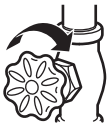
Before you call for service…
Refrigerator does not operate
- Refrigerator in defrost cycle.
Wait about 30 minutes for defrost cycle to end.
- Either or both controls set to OFF.
Set the controls toa temperature setting.
- Refrigerator is unplugged.
Push the plug completely into the outlet.
- The fuse is blown/circuit breaker is tripped.
Replace fuse or reset the breaker.
- The refrigerator is in showroom mode.
Unplug the refrigerator and plug it back in.
Vibration or rattling (slight vibration is normal)
- Rollers need adjusting.
See Rollers.
Motor operates for long periods or cycles on and off frequently. (Modern refrigerators with more storage space and a larger freezer require They start and stop often to maintain even temperatures.)
- Normal when refrigerator is first plugged in.
Wait 24 hours for the refrigerator to completely cool down.
- Often occurs when large amounts of food are placed in refrigerator.
This is normal.
- Door left open.
Check to see if package is holding door open.
- Hot weather or frequent door openings.
This is normal.
- Temperature controls set at the coldest setting.
See About the controls.
Refrigerator or freezer compartment too warm
- Temperature control not set cold enough.
See About the controls.
- Warm weather or frequent door openings.
Set the temperature control one step colder. See About the controls.
- Door left open.
Check to see if the package is holding door open.
Frost or ice crystals on frozen food (frost within package is normal)
- Door left open.
Check to see if the package is holding door open.
- Too frequent or too long door openings.
Divider between refrigerator and freezer compartments feels warm
- Automatic energy saver system circulates warm liquid around front edge of freezer compartment.
This helps prevent condensation on the outside.
Automatic ice maker does not work
- Ice maker power switch is in the off position.
Set the power switch to the on position.
- Water supply turned off or not connected.
See installing the waterline.
- Freezer compartment too warm.
Wait 24 hours for the refrigerator to completely cool down.
- Piled up cubes in the storage bin cause the ice maker to shut off.
Level cubes by hand.
- Ice cubes stuck in ice maker. (Green power light on ice maker blinking).
Tum off the ice maker. remove cubes and tum the ice moker back on.
Frequent “buzzing” sound
- Ice maker power switch is in the I (on) position, but the water supply to the refrigerator has not been connected.
Set the power switch to the O offi position. Keeping it in. the I (on) position wil damage the water valve.
Ice cubes have odor/taste
- Ice storage bin needs cleaning.
Empty and wash bin. Discard old cubes.
- Food transmitting odor/taste to ice cubes.
Wrap foods well.
- Interior of refrigerator needs cleaning.
See Care and cleaning.
Small or hollow cubes
- Water filter clogged.
Replace fiter cartridge with new cartridge or with plug.
Slow ice cube freezing
- Door left open.
Check to see f package is holding door open.
- Temperature control not set cold enough.
See About the controls.
Cube dispenser does not work
- Ice maker turned off or water supply turned off.
Tum on ice maker or water supply.
- An item is blocking or has fallen into the ice chute inside the top door bin of the freezer.
Remove any item that might be blocking. or has fallen into the chute.
- Ice cubes are frozen to ice maker feeler arm.
Remove cubes.
- Irregular ice clumps in storage container.
Break up with fingertip pressure and discord remaining clumps.
- Dispenser is LOCKED.
Freezer may be too worm. Adjust the freezer control to a colder setting. one position at a time. until clumps do not form.
Water has poor taste/odor
- Water dispenser has not been used for a long time.
Dispense water until all water in system is replenished.
Water in first glass is warm
- Normal when refrigerator is first installed.
Wait 24 hours for the refrigerator to completely cool down.
- Water dispenser has not been used for a long time.
Dispense water until all water in system is replenished.
- Water system has been drained.
Allow several hours for replenished supply to chill.
Water dispenser does not work
- Water supply line turned off or not connected.
See Installing the water line.
- Water filter clogged.
Replace filter cartridge or remove filter and install plug.
- Air may be trapped in the water system.
Press the dispenser arm for at least two minutes.
- Dispenser is LOCKED.
Press and hold the LOCK or LOCK CONTROLS pad for 3 seconds.
Water spurting from dispenser
- Newly-installed filter cartridge.
Run water from the dispenser for 3 minutes (about one and a half gallons).
Water is not dispensed but ice maker is working
- Water in reservoir is frozen.
Call for service.
- Refrigerator control setting is too cold.
Set to a warmer setting.
No water or ice cube production
- Supply line or shutoff valve is clogged.
Calla plumber.
- Water filter clogged.
Replace filter cartridge or remove filter and install plug.
- Dispenser is LOCKED.
Press and hold the LOCK or LOCK CONTROLS pad for 3 seconds.
CUBED ice was selected but CRUSHED ice was dispensed
- Last setting was CRUSHED.
A few cubes were left in the crusher from the previous setting. This is normal.
Orange glow in the freezer
- Defrost heater is on.
This is normal.
Refrigerator has odor
- Foods transmitting odor to refrigerator.
Foods with strong odors should be tightly wrapped.
Keep an open box of baking soda in the refrigerator; replace every three months.
- Interior needs cleaning.
See Care and cleaning.
Door not closing properly
- Door gasket on hinge side sticking or folding over
Apply petroleum jelly to the face of the gasket.
- A door bin is hitting a shelf inside the refrigerator.
Move the door bin up one position.
Moisture forms on outside of refrigerator
- Not unusual during periods of high humidity.
Wipe surface dry.
Moisture collects inside (in humid weather, air carries moisture into refrigerator when doors are opened)
- Too frequent or too long door openings.
This is normal for the beverage center.
- Due to the higher humidity in the refrigerator, you may on occasion experience fog or small amounts of moisture in the refrigerator compartment.
This is normal and may come and go as different food loads and environmental conditions change. Wipe dry with a paper towel f desired.
Interior light does not work
- No power at outlet.
Replace fuse or reset the breaker.
- Light bulb burned out.
See Replacing the light bulbs.
- For LED lights
Call Service.
Water on kitchen floor or on bottom of freezer
- Cubes jammed in chute.
Poke ice through with a wooden spoon.
Hot air from bottom of refrigerator
- Normal air flow cooling motor. In the refrigeration process, it is normal that heat be expelled in the area under the refrigerator. Some floor coverings are sensitive and will discolor at these normal and safe temperatures.
Refrigerator never shuts off but the temperatures are OK
- Adaptive defrost keeps compressor running during door openings.
This is normal. The refrigerator will cycle off after the door remains closed for 2 hours.
Refrigerator beeping
- Door open.
Close door.
Food isn’t thawing/ chilling
- Packaging.
Increase time or re-package in plastic.
- Wrong weight selected.
Select a larger weight.
- Item with high-fat content.
Select a larger weight.
- Not using Chill/Thaw tray.
Place items on tray and allow space in between items for better airflow.
Actual temperature not equal to Set temperature
- Unit just plugged in.
Allow 24 hours for system to stabilize.
- Door open for too long
Allow 24 hours for system to stabilize.
- Warm food added to refrigerator.
Allow 24 hours for system to stabilize.
- Defrost cycle is in process.
Allow 24 hours for system to stabilize.
SelectTemp or Beverage Center feature is not working
- Refrigerator compartment temperature control is set at warmest setting.
This is normal In order to minimize energy usage the Select Temp and Beverage Center features are disabled when the refrigerator temperature control is set at the warmest setting.
- Beverage Center feature turns off after six months of continuous operation.
Press Beverage Center pad to restart.
While QuickFreeze™ is enabled, the actual freezer temperature may drop as low as –3°F (–19°C)
This is normal.
See other models: JGS968SEK3SS JGBP90MEB4BC ZDP486LDP4SS AJEQ12DCFL1 ZDIW50YA
